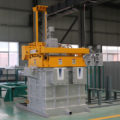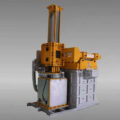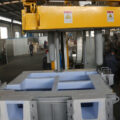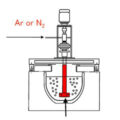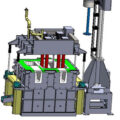At present, the online degassing of molten aluminum is more widely used for molten aluminum purification. The on-line degassing equipment produced by AdTech is installed between the furnace and the casting machine to eliminate hydrogen and other residues contained in the molten aluminum and its alloys that affect its quality and mechanical properties. The degassing efficiency is stable at 60% on average.

Online Degassing of Molten Aluminum
To make the online degassing work of molten aluminum stably and efficiently, the following points need to be paid attention to:
The degassing unit is required to have good airtightness, be less affected by the climate, produce less slag, and will not form secondary pollution. When the degassing box is poorly sealed, the water vapor in the air will easily enter the furnace to form hydrogen absorption. The early degassing units mainly used high-purity nitrogen as a covering gas to reduce hydrogen absorption, but it will also be affected by the weather to a certain extent Impact. Therefore, in order to improve the degassing efficiency and reduce the influence of climate, the degassing equipmet is required to have a good seal.
The bubbles in the degassing box are required to be finely dispersed and uniform, and there is no big tumbling of the liquid level. When the total flow and pressure of the process gas in the degassing machine remain unchanged, the larger the number of bubbles, the larger the contact area between the process gas and the melt. Therefore, the smaller the bubbles (equivalent to the greater the number of bubbles) and the greater the number of bubbles. Dispersion, the larger the contact area, the more conducive to the diffusion of hydrogen into the process gas to achieve the purpose of hydrogen removal. The rotor must have enough stirring power to make the bubbles have enough moving speed to disperse the entire molten pool, but the rotor speed is too fast will cause the liquid surface to roll, and may make the slag re-enter the melt.
The rotor structure of the degassing unit is required to have sufficient stirring power. The rotor rod and rotor impeller must have a reasonable structure, appropriately increase the diameter of the impeller, and match it with an appropriate speed to increase the stirring force of the rotor.
The process gas is required to have high purity, and it is not possible to make slag and absorb hydrogen from the melt. Generally, the control of process gas purity is mainly two part, one is the control of the gas source, and the other is the control of the leakage of all pipes and instruments through which the gas passes. Generally, the purity of the process gas source is required to reach 99.999%, the water content is less than 4 × 10-6, and the oxygen content is less than 5 × 10-6. Excessive water and oxygen content in the process gas will cause slagging and hydrogen absorption.
In order to ensure that the melt has sufficient residence time in the degassing device, a certain volume of the molten pool is required. Degassing unit rotor to melt must be a certain immersion depth. The immersion depth of the rotor is directly related to whether the entire molten pool can be completely covered by the process gas, which has a more obvious impact on the degassing efficiency. Generally, the immersion depth of the rotor and the impeller should be greater than 500mm, and the distance between the impeller and the bottom of the molten pool should be 50~100mm.
The degassing unit is required to have good insulation performance and low furnace shell temperature. Generally, the installed furnace capacity in the degassing unit is about 550~650kg.
Calculated with an hourly throughput of 2t, the residence time of the aluminum melt in the furnace is about 15 minutes. If the heat preservation performance of the degassing system is poor, it is necessary to increase the heating power of the degassing equipment or increase the temperature of the holding furnace in order to ensure the front box temperature. Increasing the temperature will significantly increase the solubility of hydrogen and increase the hydrogen absorption capacity of the melt. Therefore, these two measures will increase the hydrogen content of the melt. Therefore, the degassing unit is required to have good insulation performance, and the temperature of the furnace shell is generally lower than 75°C.
The furnace lining and aluminum are required to be non-wet and easy to clean. The lining of the degassing unit generally requires refractory materials that are not wet with aluminum, have stable performance, do not add gas to the melt, are resistant to high temperature sintering, and are not easy to accumulate slag.
The above measures ensure the stable operation of the degassing equipment. Under normal circumstances, the degassing efficiency should reach more than 50%. Pay attention to daily measurement and verification, and check the equipment and deal with it if any abnormality is found.



